fuel pressure AUDI A8 2018 Owners Manual
[x] Cancel search | Manufacturer: AUDI, Model Year: 2018, Model line: A8, Model: AUDI A8 2018Pages: 356, PDF Size: 54.71 MB
Page 6 of 356
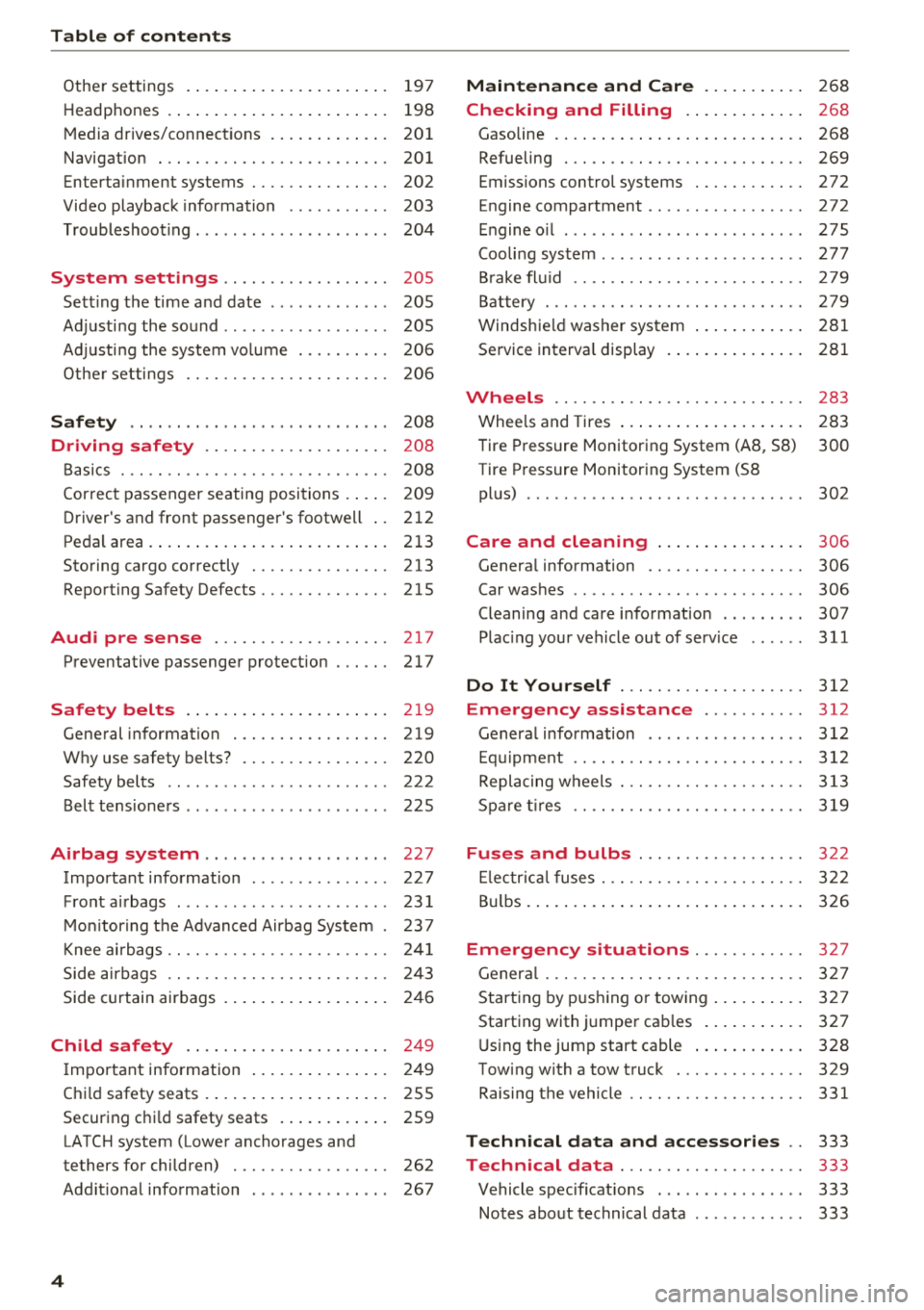
Table of contents
Other settings . . . . . . . . . . . . . . . . . . . . . . 197
H eadphon es . . . . . . . . . . . . . . . . . . . . . . . . 198
M edia drives/connect ions . . . . . . . . . . . . . 201
Navigation . . . . . . . . . . . . . . . . . . . . . . . . . 201
Enterta inment systems . . . . . . . . . . . . . . . 202
Video playback information . . . . . . . . . . . 203
T roubleshoot ing . . . . . . . . . . . . . . . . . . . . . 204
System settings . . . . . . . . . . . . . . . . . . 205
Sett ing the time and date . . . . . . . . . . . . . 205
Ad justi ng the sound . . . . . . . . . . . . . . . . . . 205
Ad justi ng the system vo lume ... .... .. .
Othe r settings .. ............. .. .. .. . 206
206
Safety .. .. .. .. ... .. ..... ... .. .. .. . 208
Driving safety . . . . . . . . . . . . . . . . . . . . 208
B asics . . . . . . . . . . . . . . . . . . . . . . . . . . . . . 20 8
Cor rect passenger seating positions . . . . . 209
D river's and front passenge r's footwell . . 212
Peda l area. ........ .. ..... ... .. .. ... 213
Storing cargo correctly . . . . . . . . . . . . . . . 213
Report ing Safety Defects....... .... .. . 215
Audi pre sense . . . . . . . . . . . . . . . . . . . 217
Preventative passenger protection . . . . . . 217
Safety belts . . . . . . . . . . . . . . . . . . . . . . 2 19
Gene ral information . . . . . . . . . . . . . . . . . 219
W hy use safety belts? . . . . . . . . . . . . . . . . 220
Safety belts . . . . . . . . . . . . . . . . . . . . . . . . 222
Belt tensioners . . . . . . . . . . . . . . . . . . . . . . 225
Airbag system . . . . . . . . . . . . . . . . . . . . 227
Important information . . . . . . . . . . . . . . . 227
F ront a irbags . . . . . . . . . . . . . . . . . . . . . . . 23 1
M on itor ing t he Advanced Airbag System . 237
Knee ai rbags . . . . . . . . . . . . . . . . . . . . . . . . 24 1
Side air bags . . . . . . . . . . . . . . . . . . . . . . . . 24 3
Side c urtain airbags . . . . . . . . . . . . . . . . . . 246
Child safety . . . . . . . . . . . . . . . . . . . . . . 24 9
I mportant info rmation . . . . . . . . . . . . . . . 24 9
Chi ld safety seats . . . . . . . . . . . . . . . . . . . . 255
Securing chi ld safety seats . . . . . . . . . . . . 259
LATCH system (Lower anchorages and
tethers for children) . . . . . . . . . . . . . . . . . 262
Add it io nal information . . . . . . . . . . . . . . . 267
4
Maintenance and Care . . . . . . . . . . . 2 68
Checking and Filling . . . . . . . . . . . . . 268
Gasoline . . . . . . . . . . . . . . . . . . . . . . . . . . . 268
Refueling . . . . . . . . . . . . . . . . . . . . . . . . . . 269
Emissions control systems . . . . . . . . . . . . 272
Engine compartment . . . . . . . . . . . . . . . . . 272
E ngine o il . . . . . . . . . . . . . . . . . . . . . . . . . . 275
Cooli ng system . . . . . . . . . . . . . . . . . . . . . . 277
B rake fl uid . . . . . . . . . . . . . . . . . . . . . . . . . 279
Bat tery . . . . . . . . . . . . . . . . . . . . . . . . . . . . 279
Windsh ie ld washer sys tem . . . . . . . . . . . . 281
Service in terva l display 281
Wheels .... .. .. .. .. ............. .. 28 3
Whee ls and Tires . . . . . . . . . . . . . . . . . . . . 283
T ire Pressure Monitoring System (AB , 58) 300
Tire P ressure Monitor ing System (58
pl us) . . . . . . . . . . . . . . . . . . . . . . . . . . . . . . 302
Care and cleaning . . . . . . . . . . . . . . . . 306
Genera l information . . . . . . . . . . . . . . . . . 306
Car washes . . . . . . . . . . . . . . . . . . . . . . . . . 306
Cleaning and care info rmation . . . . . . . . . 307
Plac ing your vehicle out of serv ice . . . . . . 311
Do It Yourself . . . . . . . . . . . . . . . . . . . . 312
Emergency assistance . . . . . . . . . . . 312
Genera l information . . . . . . . . . . . . . . . . . 312
E qu ipment . . . . . . . . . . . . . . . . . . . . . . . . . 312
Repla cing wheels . . . . . . . . . . . . . . . . . . . . 313
Spa re tir es . . . . . . . . . . . . . . . . . . . . . . . . . 319
Fuses and bulbs . . . . . . . . . . . . . . . . . . 32 2
El ec trica l fuses . . . . . . . . . . . . . . . . . . . . . . 322
B ul bs . . . . . . . . . . . . . . . . . . . . . . . . . . . . . . 3 26
Emergency situations . . . . . . . . . . . . 327
Gener al . . . . . . . . . . . . . . . . . . . . . . . . . . . . 32 7
Start ing by p ushi ng o r tow ing . . . . . . . . . . 3 27
Starting with jumper cab les . . . . . . . . . . . 327
U sing the jump start cable . . . . . . . . . . . . 328
Towing with a tow truck . . . . . . . . . . . . . . 329
Raising the vehicle . . . . . . . . . . . . . . . . . . . 331
Technical data and a ccessories . . 333
Technical data . . . . . . . . . . . . . . . . . . . . 333
Vehicle specificat ions . . . . . . . . . . . . . . . . 333
Notes abo ut technical data . . . . . . . . . . . . 333
Page 26 of 356
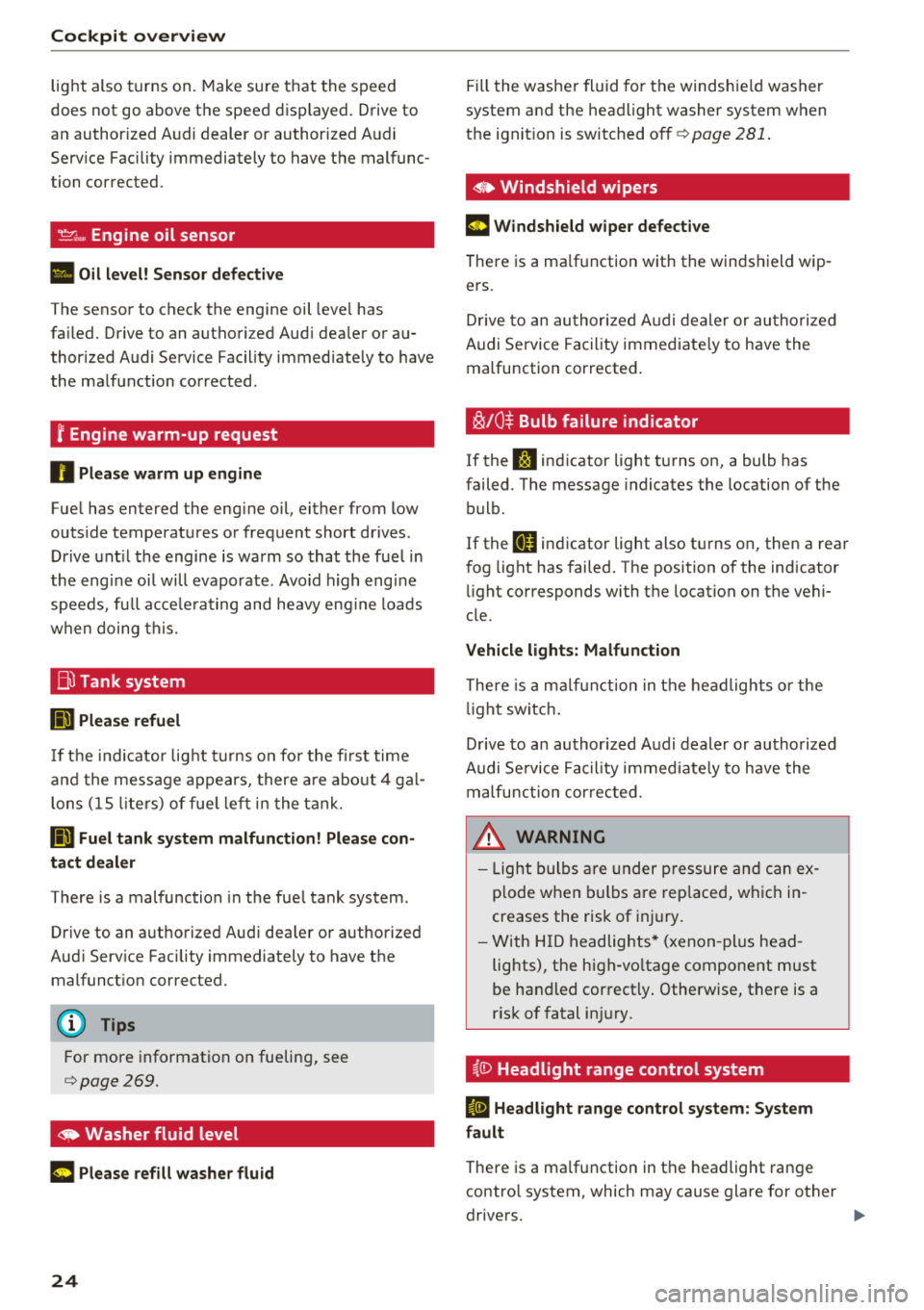
Cockpit overv ie w
lig ht also turns on. Make sure t hat the speed
does not go above the speed displayed. Drive to
an author ized Audi dealer or authorized A udi
Serv ice Facility immediately to have the malfunc
tion corrected .
--... Engine oil sensor
• Oil l evel! Sen sor d efe ctiv e
The sensor to check the engine oil leve l has
fa iled. Drive to an authori zed Aud i dea ler or au
thor ized Audi Service Facility immed iate ly to have
the ma lfunction corrected .
f Engine warm-up request
0 Plea se warm up engine
Fue l has entered the eng ine oil, either from low
outside temperatures or frequent short drives .
Dr ive unt il the engine is warm so that the fuel in
the eng ine oi l will evaporate . Avo id h igh eng ine
speeds, fu ll acce le rating and heavy eng ine loads
when doing this.
jjl Tank system
Ill Plea se refuel
If t he i nd icator lig ht t urns on fo r the fi rst time
a nd the mess age appears, there a re abo ut 4 ga l
lons (15 lite rs) of fue l le ft in the tank.
D Fuel tank s ystem malfunction! Plea se con
tact dealer
There is a malfunction in the fue l tank system .
Drive to an a uthorized Audi dea ler or a uth orized
Aud i Serv ice Facility immediately to have the
malfunct ion corrected.
(D Tips
For more information on fueling, see
¢page 269 .
~ Washer fluid level
C Please refill washer flu id
24
Fill the washer fluid for the windshie ld washer
system and the head light washer system when
t h e ignit ion is switched
off ¢ page 281 .
• Windshield wipers
m Windshield wiper defective
There is a ma lfunction with the winds hield wip
ers .
D rive to an au thor ized A udi dealer or au tho riz ed
Audi Se rvice Facility immediate ly to have the
malfunction corrected.
~ /0~ Bulb failure indicator
If the S:$ ind icator light turns on, a bulb has
failed . The message indicates the location of the
bulb.
If the
II indicator light also t urns on, then a rear
fog light has failed. The position of the indicator
li ght corresponds with the location on the vehi
cle.
Vehicle light s: Malfunction
There is a m alfu nction in the headlights o r the
li gh t sw itch .
D rive to an author ized Audi dealer or autho rized
Audi Se rvice Fac il ity immed iate ly to have the
malfunction cor rec ted .
_& WARNING
-Light bulbs are under pressure and can ex
p lode when b ulbs a re rep laced, w hic h in
creases the ris k of in jury.
- With H ID headlig hts* (xenon -plus head
lights), the high-vo ltage component must
be handled correct ly . Otherwise, there is a
risk o f fatal in jury.
§.0 Headlight range control system
El He adlight range cont rol system: System
fault
There is a ma lfunction in the headlight range
contro l system, which may cause glare for other
drivers.
-
Page 76 of 356
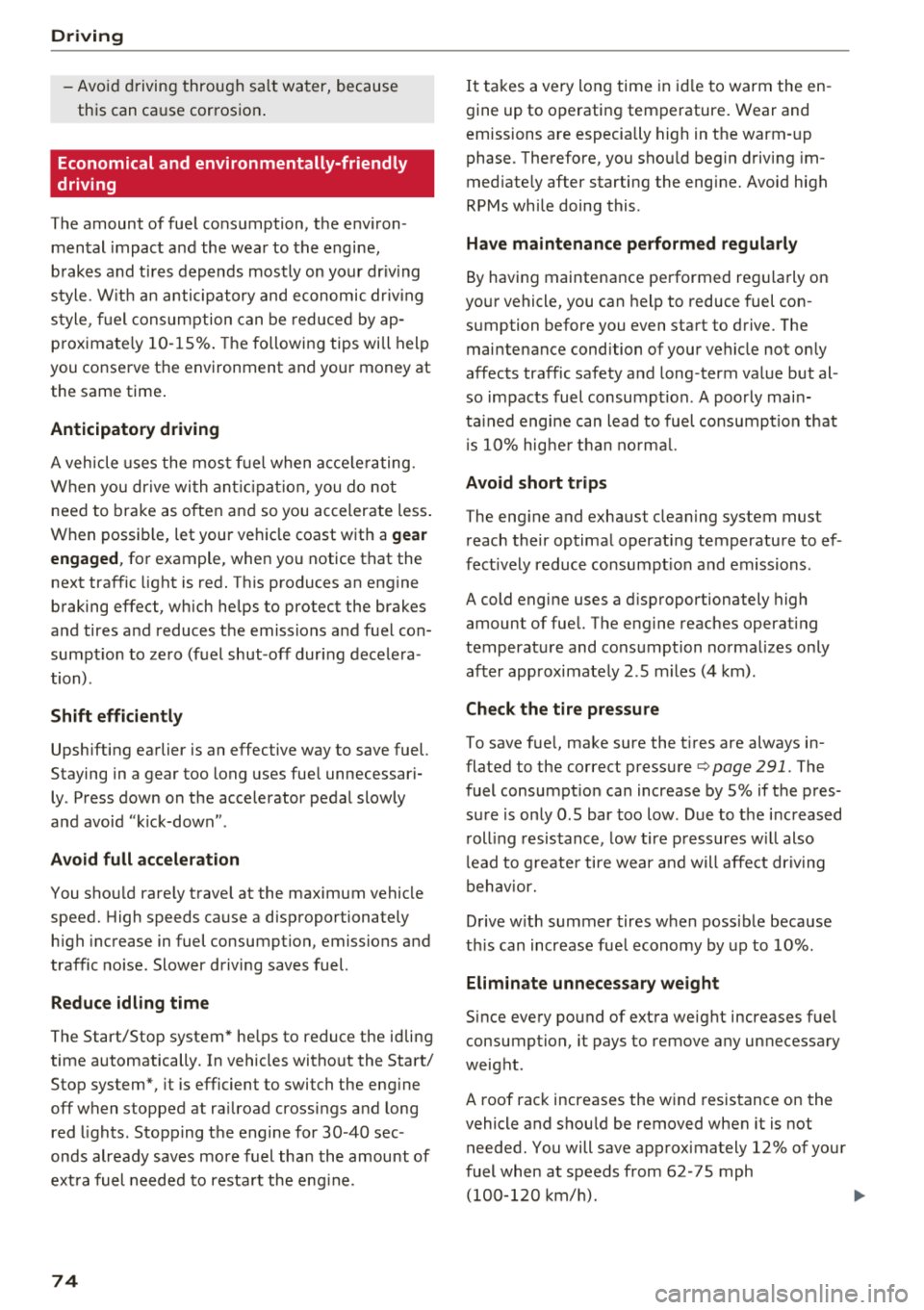
Drivin g
-Avoid driving through sa lt water, because
this can cause corrosion .
Economical and environmentally-friendly
driving
The amount of fuel consumption, the env iron
mental impact and the wear to the engine,
brakes and t ires depends mostly on your dr iv ing
style. W it h an anticipatory and economic dr iv ing
style , fu el consumption can be reduced by ap
p roximate ly 10 -15% . The following tips wi ll help
you conserve the environment and your money at the same time .
Anticipatory driving
A veh icle uses the most fuel when acce le rating.
When you dr ive with ant ic ipat io n, you do no t
need to brake as often and so you accelerate less .
When possib le, let your vehicle coast with a
gear
eng aged ,
for example, when you notice that the
next traffic light is red. This produces an engine
braking effect, which helps to protect the brakes
and tires and reduces the emissions and fuel con
sumpt ion to zero (fuel shut -off during decelera
tion) .
Shift efficientl y
Upshifting earlier is an effective way to save fuel.
Staying in a gear too long uses fue l unnecessari
ly . Press down on the accelerator pedal slowly
and avoid "k ick-down" .
Avoid full accel eration
You shou ld rare ly trave l at the maximum vehicle
speed. High speeds cause a disproportionately h igh increase in fuel consumption, emissions and
traffic no ise . Slower driving saves fuel.
Reduce idlin g time
The Start/Stop system* he lps to reduce the idling
time automatically. In vehicles without the Start/
Stop system*, it is efficient to switch the eng ine
off when stopped at ra ilroad crossings and long
red l ights . Stopp ing the engine for 30 -40 sec
onds already saves more fuel than the amount of
ext ra fuel needed to resta rt the eng ine.
74
It takes a ve ry long time in id le to warm the en
gine up to operating temperature. Wear and
emissions are especially high in the warm -up
phase. Therefore, you shou ld begin driving im
med iate ly after starting the engine. Avoid high
RPMs while doing this .
Hav e maintenance perfo rmed regul arly
By having maintenance performed reg ularly on
your vehicle, you can help to reduce fuel con
sumption before you even start to drive. The maintenance condition of your vehicle not on ly
affects traffic safety and long-term value but al
so impacts fuel consumpt ion. A poorly main
ta ined engine can lead to fuel consumpt ion that
i s 10% hig he r th an no rma l.
Avoid short trip s
The engine and exhaust cleaning system must
reach their optimal operat ing temperature to ef
fect ively reduce consumpt ion and emissions .
A cold engine uses a d isproportionately high
amount of fuel. The engine reaches operat ing
temperature and consumption normalizes only
after approximately 2 .5 m iles (4 km) .
Check the tire pressu re
To save fue l, make sure the t ires are always in
flated to the correct pressure
¢ page 291. The
fuel consumpt ion can increase by 5% if the pres
sure is only 0 .5 bar too low . Due to the increased
r oll ing resistance, low tire p ressures w ill also
l ead to greater tire wear and will affe ct driv ing
behav ior.
Drive w ith summer tires when poss ible because
t hi s can increase fue l economy by up to 10% .
Eliminate unnecessary weight
Since every pound of extra weight increases fuel
consumption, it pays to remove any unnecessary
weight.
A roof rack increases the w ind resistance on the
vehicle and shou ld be removed when it is not
needed. You will save approximately 12% of your
fuel when at speeds from 62-75 mph (100-120 km/ h).
.,.
Page 85 of 356
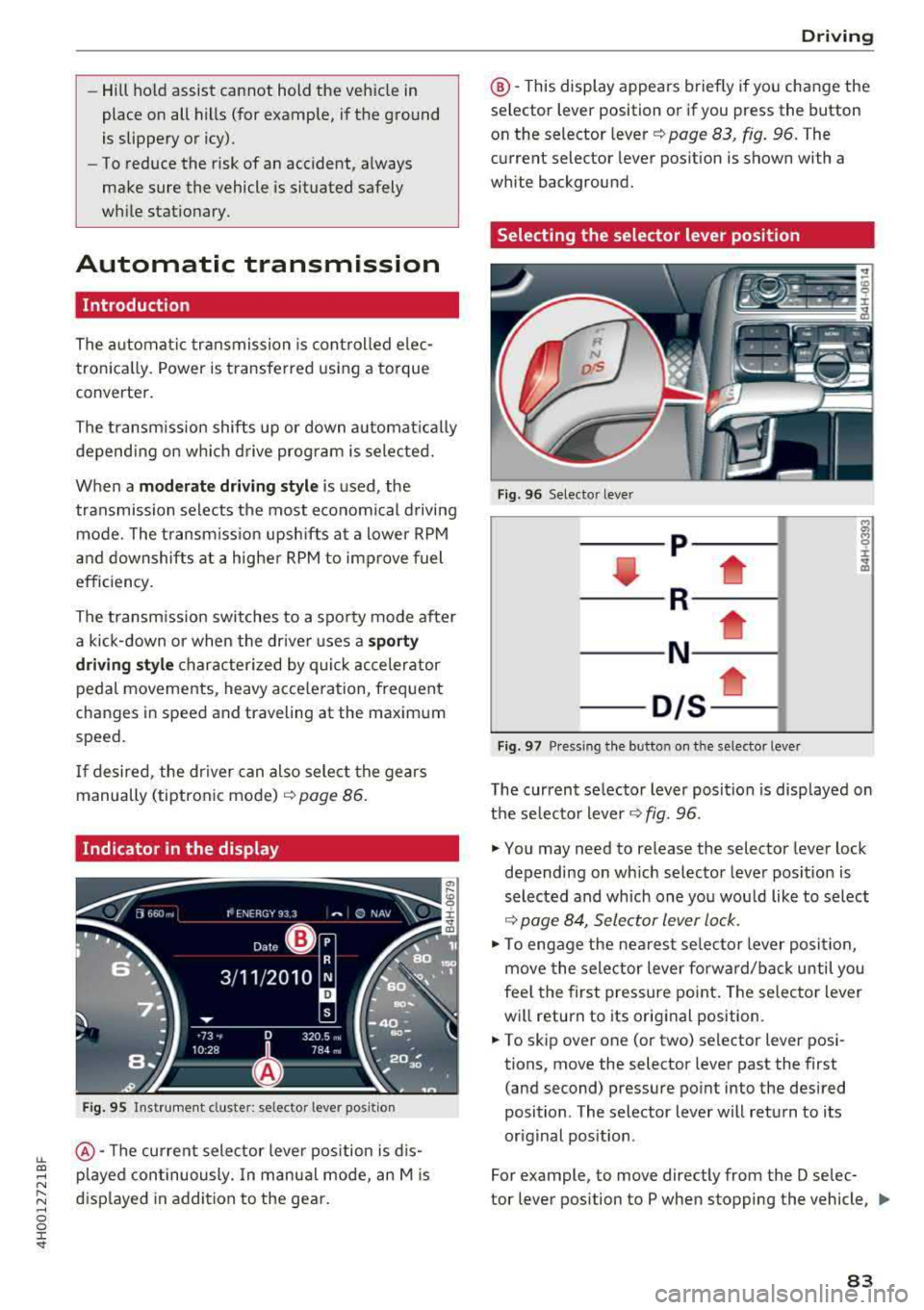
lL t:0 ....
"' ......
"' .... 0 0 :c '
place on all h ills (for example, if the ground
is slippery or icy).
- To reduce the risk of an accident, always
make sure the vehicle is situated safely
while stat ionary.
Automatic transmission
Introduction
The automat ic transmission is controlled e lec
tron ica lly. Power is transferred using a torque
converter.
The transm ission shifts up or down automat ically
depending on wh ich drive program is selected.
When a
mod erate driving s tyle is used, the
transmission selects the most e conomical d riving
mode. The t ransm iss ion upsh ifts at a lower RPM
and downshifts at a highe r RPM to imp rove fuel
efficiency.
The transm ission switches to a spor ty mode after
a kick-down or when the driver uses a
sp o rt y
driving style
c haracterized by quick accelerator
pedal movements, heavy acce leration, frequent
changes in speed and traveling at the maximum
speed.
If desired, the dr iver can also select the gears
manually (tiptronic mode)
c::> page 86.
Indicator in the display
F ig . 95 Inst rument cluster: selector lever positio n
@ -The current selector leve r position is d is
p layed continuously. In manua l mode, an Mis
displayed in addition to the gear.
D rivi ng
@ -This display appea rs briefly if you change the
selector lever position or if you press the button
on the selector lever
c::> page 83, fig. 96. The
current selector lever position is shown with a
white background.
Selecting the selector lever position
F ig. 96 Selector lever
-- p- -
----R--- --1
----N--- -i;
-01s*
Fig. 97 Pressing the button on the selector leve r
The current selector lever posit ion is disp layed on
t h e selecto r lever
c::> fig. 96 .
.,. You may need to release the selector lever lock
depending on wh ich selector lever pos ition is
selected and which one you wou ld like to select
c::> page 84, Selector lever lock .
.,. To engage the nearest selector lever position,
move the selector lever forward/back until you
fee l the first pressure point. The selector lever
wi ll return to its original position .
.,. To skip over one (or two) selector lever posi
tions, move the selector lever past the first
(and second) pressure point into the desired
position . The selector lever will return to its
or ig inal position .
For example, to move directly from the D selec-
tor lever position to P when stopping the vehicle,
II>
83
Page 288 of 356
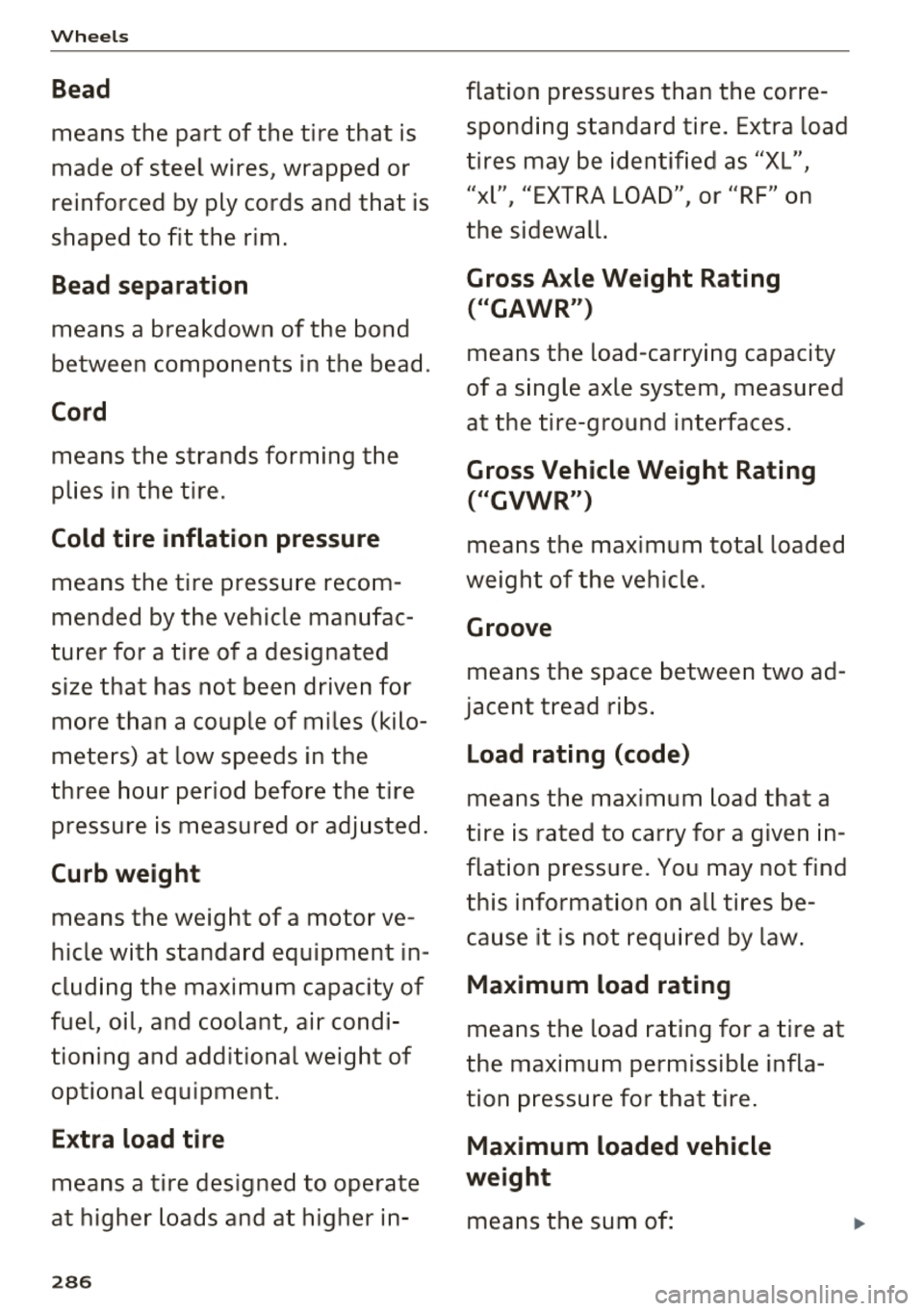
Wheels
Bead
means the part of the tire that is
made of steel wires, wrapped or
reinforced by ply cords and that is
shaped to fit the rim .
Bead separation
means a breakdown of the bond
between components in the bead .
Cord
means the strands forming the
plies in the tire .
Cold tire inflation pressure
means the tire pressure recom
mended by the vehicle manufac
turer for
a tire of a designated
size that has not been driven for more than a couple of miles (kilo
meters) at low speeds in the
three hour period before the tire pressure is measured or adjusted .
Curb weight
means the weight of a motor ve
hicle with standa rd equipment in
cluding the maximum ca pacity of
fuel, oil, and coolant, air condi
tioning and addit ional weigh t of
optional equipment.
E x tra load tire
means a tire designed to operate
at higher loads and at higher
in -
28 6
flation pressures than t he corre
spond ing standard tire. Extra load
tires may be identified as "X L",
"xl" , "EXTRA LOAD" , or "RF" on
the sidewall.
Gross Axle Weight Rating ("GAWR")
means the load-car rying capacity
of a single axle system , measu red
at the ti re-ground interfaces .
Gross Vehicle Weight Rating
("GVWR")
means the maximum total loaded
weight of the vehicle .
Groove
means the space between two ad
jacent tread ribs .
Load rating (code)
means the maximum load tha t a
tire is rated to carry for a given i n
flation pressure. You may no t find
this informat ion on all ti res be
cause it is not required by law .
Maximum load rating
means the load rating for a tire at
the maximum permissible infla
tion pressure for that tire .
Maximum loaded vehicle
weight
means t he sum of:
Page 296 of 356
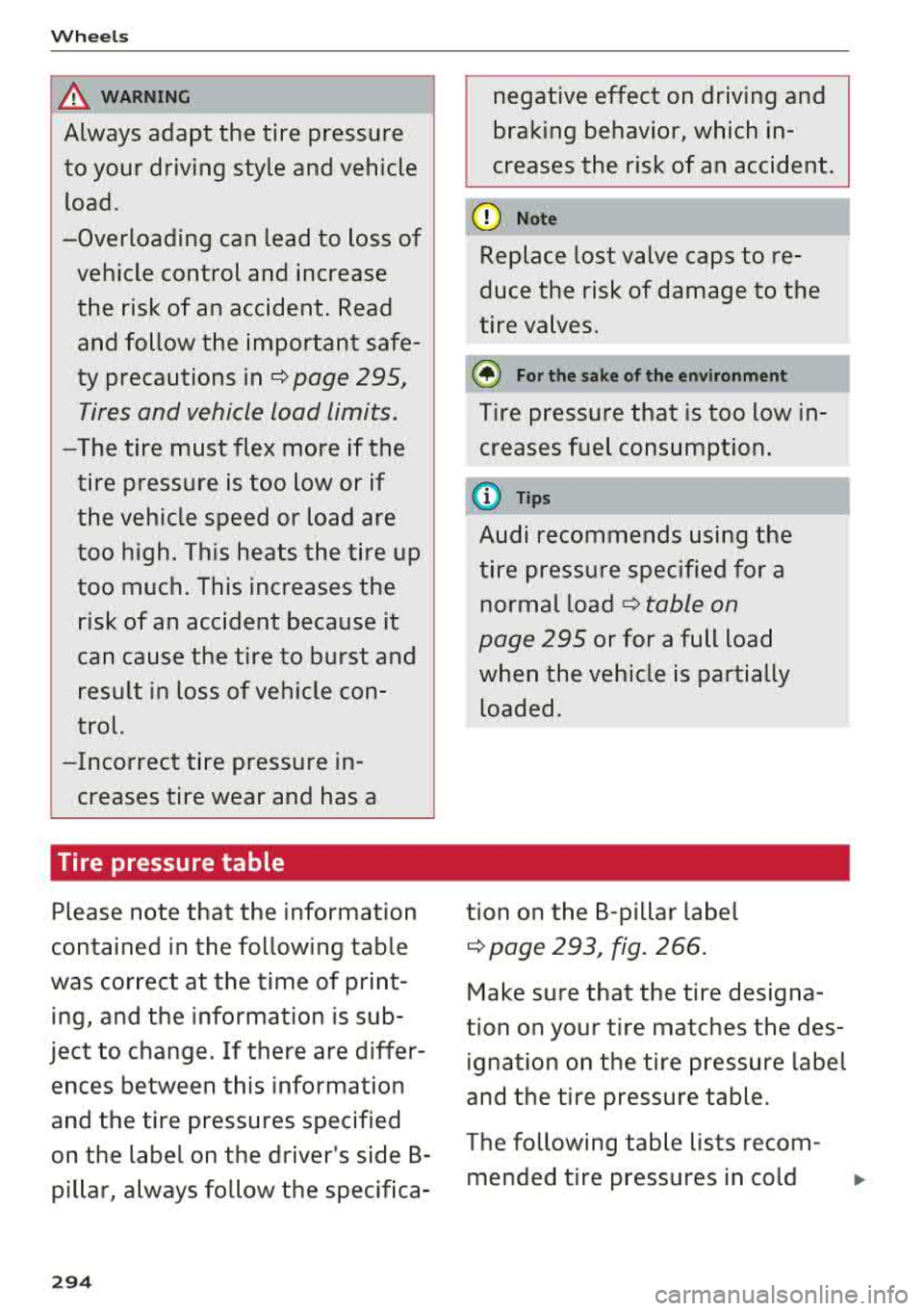
Wheels
&,. WARNING
Always adapt the tire pressure
to your driving style and vehicle
load .
-Overloading can lead to loss of
vehicle control and increase
the risk of an accident. Read and follow the important safe
ty precautions
inc:::> page 295,
Tires and vehicle load limits.
-The tire must flex more if the
tire pressure is too low or if
the vehicle speed or load are
too high . This heats the tire up
too much. This increases the
risk of an accident because it
can cause the tire to burst and
result in loss of vehicle con
trol.
-Incorrect tire pressure in creases tire wear and has a
Tire pressure table
Please note that the information
contained in the following table
was correct at the time of print
ing, and the information is sub
ject to change. If there are differ ences between this information
and the tire pressures specified
on the label on the driver's side B pillar, always follow the specifica-
294
negative effect on driving and
braking behavior, which in
creases the risk of an accident.
@ Note
Replace lost valve caps to re
duce the risk of damage to the
tire valves.
@ For the sake of the environment
Tire pressure that is too low in
creases fuel consumption.
(D Tips
Audi recommends using the
tire pressure specified for a normal load
c:::> table on
page 295
or for a full load
when the vehicle is partially loaded.
tion on the B-pillar label
c:::> page 293, fig. 266.
Make sure that the tire designa
tion on your tire matches the des ignation on the tire pressure label
and the tire pressure table.
The following table lists recom- mended tire pressures in cold
.,..
Page 300 of 356
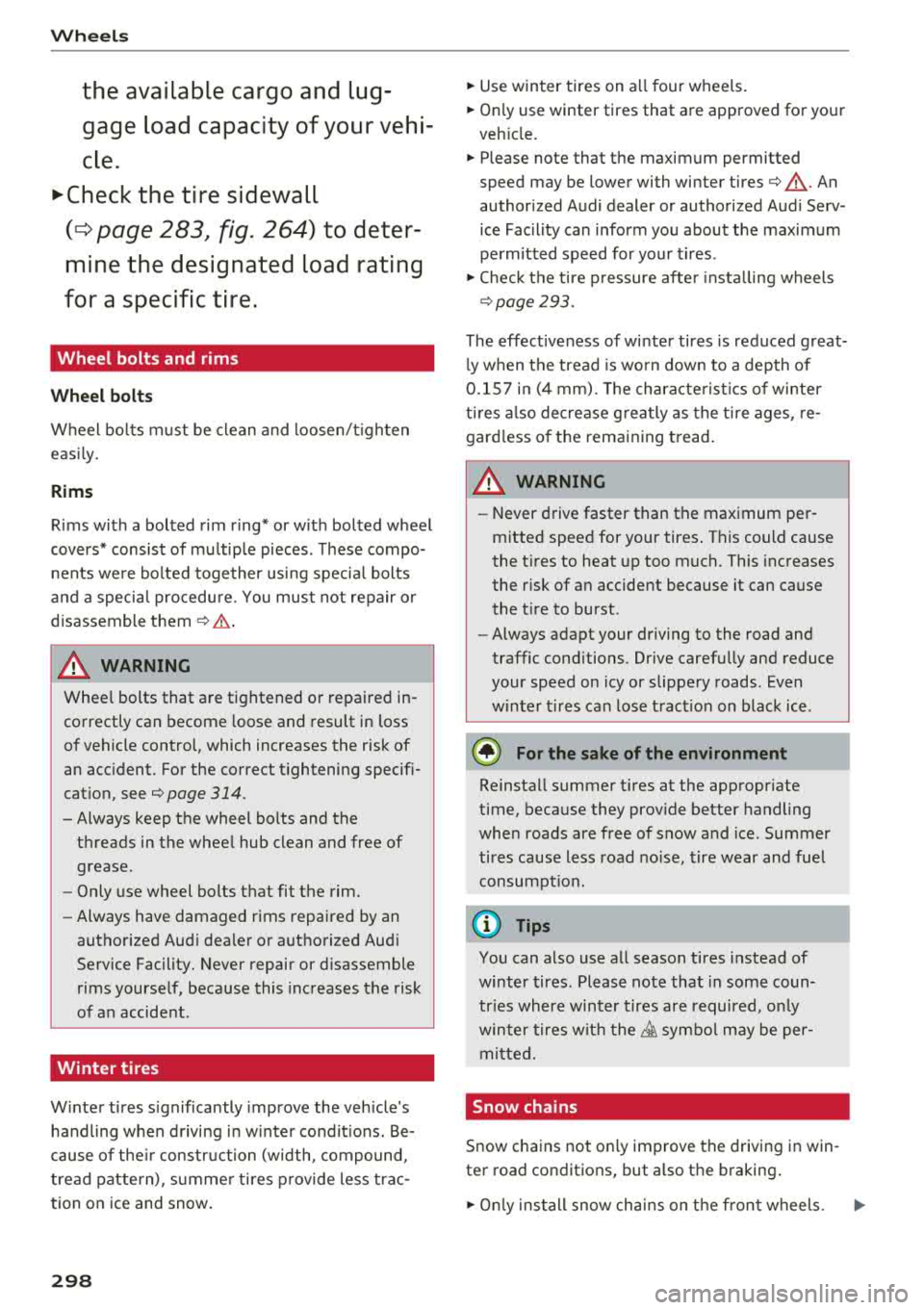
Wheels
the available cargo and luggage load capacity of your vehi
cle.
.,.Check the tire sidewall
(¢ page 283, fig. 264) to deter
mine the designated load rating
for a specific tire.
Wheel bolts and rims
Wheel bolts
Wheel bolts must be clean and loosen/tighten
easily .
Rims
Rims with a bolted rim ring* or with bolted wheel
covers* consist of multiple pieces . These compo
nents were bolted together using special bolts
and a special procedure. You must not repair or
disassemble
them £:=?.&. .
A WARNING
Wheel bolts that are tightened or repaired in
correctly can become loose and result in loss
of vehicle control, which increases the risk of
an accident. For the correct tightening specifi
cation, see
¢page 314.
- Always keep the wheel bolts and the
threads in the wheel hub clean and free of grease.
- Only use wheel bolts that fit the rim.
- Always have damaged rims repaired by an
authorized Audi dealer or authorized Audi
Service Facility. Never repair or disassemble
rims yourself, because this increases the risk
of an accident .
Winter tires
Winter tires significantly improve the vehicle's
handling when driving in winter conditions. Be
cause of their construction (width, compound,
tread pattern) , summer tires provide less trac
tion on ice and snow.
298
.. Use winter tires on all four wheels .
.. Only use winter tires that are approved for your
vehicle.
.. Please note that the maximum permitted
speed may be lower with winter
tires¢ _&.. An
authorized Audi dealer or authorized Audi Serv
ice Facility can inform you about the maximum
permitted speed for your tires .
.,. Check the tire pressure after installing wheels
¢page 293 .
The effectiveness of winter tires is reduced great
ly when the tread is worn down to a depth of
0.157 in (4 mm). The characteristics of winter
tires also decrease greatly as the tire ages , re
gardless of the remaining tread.
A WARNING
- Never drive faster than the maximum per
mitted speed for your tires. This could cause
the tires to heat up too much. This increases
the risk of an accident because it can cause
the tire to burst .
- Always adapt your driving to the road and
traffic conditions. Drive carefully and reduce
your speed on icy or slippery roads. Even
winter tires can lose traction on black ice .
® For the sake of the environment
Reinstall summer tires at the appropriate
time, because they provide better handling
when roads are free of snow and ice. Summer
tires cause less road noise, tire wear and fuel
consumption.
(D Tips
You can also use all season tires instead of
winter tires. Please note that in some coun
tries where winter tires are required, only
winter tires with the
& symbol may be per
mitted.
Snow chains
-
Snow chains not only improve the driving in win
ter road conditions, but also the braking.
.,. Only install snow chains on the front wheels. .,.
Page 304 of 356
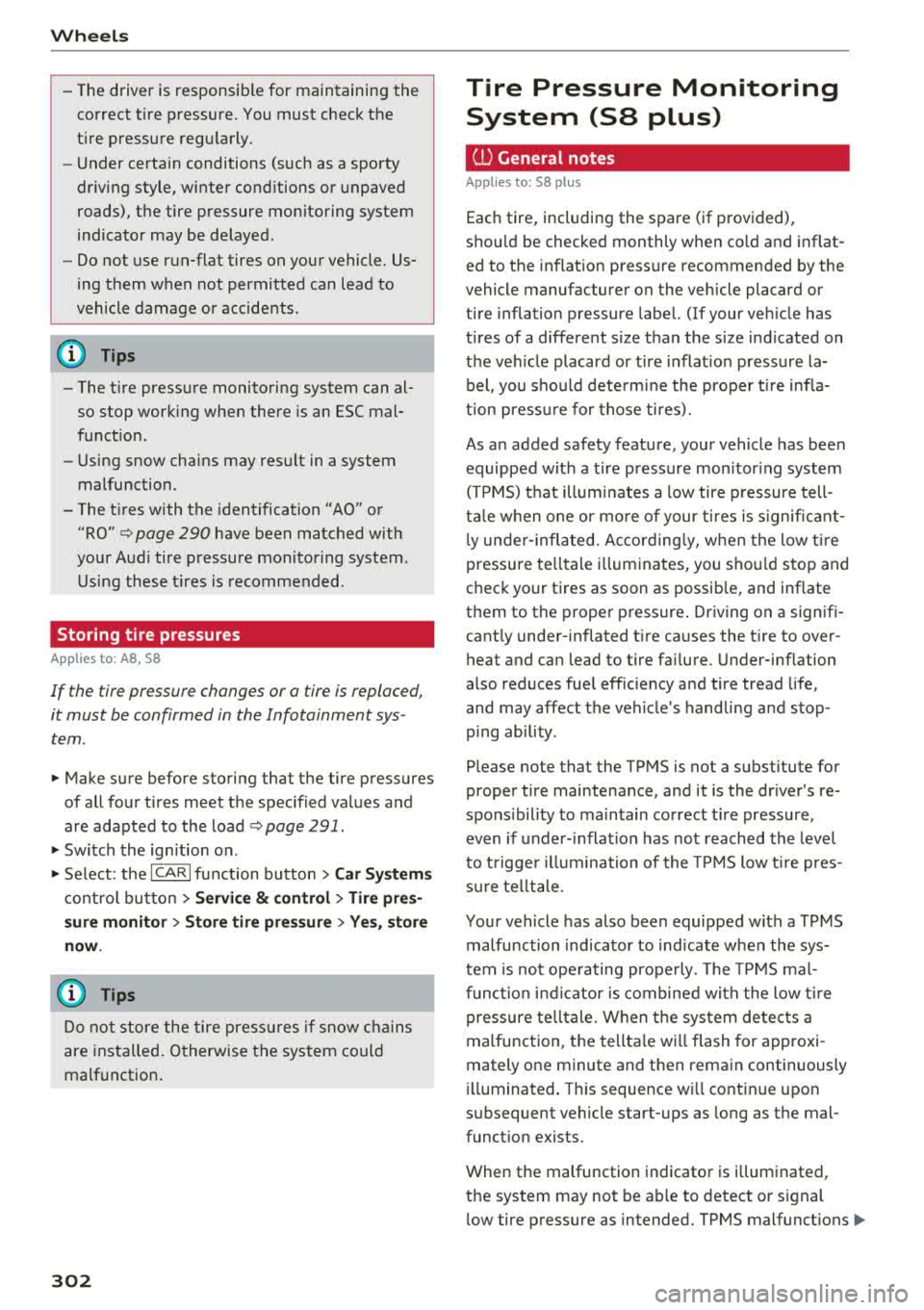
Wheels
-The driver is responsible for maintaining the
correct tire pressure. You must check the
tire pressure regularly.
- Under certain conditions (such as a sporty
driving style, winter conditions or unpaved
roads), the tire pressure monitoring system
indicator may be delayed .
- Do not use run-flat tires on your vehicle. Us
ing them when not permitted can lead to
vehicle damage or accidents .
(D Tips
- The tire pressure monitoring system can al
so stop working when there is an ESC mal
function .
- Using snow chains may result in a system
malfunction.
- The tires with the identification
"AO" or
"RO" ¢ page 290 have been matched with
your Audi tire pressure monitoring system.
Using these tires is recommended.
Storing tire pressures
Applies to: AB, S8
If the tire pressure changes or a tire is replaced,
it must be confirmed in the Infotainment sys
tem .
.,. Make sure before storing that the tire pressures
of all four tir es meet the specified values and
are adapted to the
load ¢ page 291 .
.,. Switch the ignition on .
.,. Select : the ICARI function button > Car Systems
control button > Service & control > Tire pres
sure monitor> Store tire pressure > Yes, store
now.
(D Tips
Do not store the tire pressures if snow chains
are installed. Otherwise the system could
malfunction.
302
Tire Pressure Monitoring System (SB plus)
ill General notes
Applies to: S8 plus
Each tire, including the spare (if provided),
shou ld be checked monthly when cold and inflat
ed to the inflation pressure recommended by the
vehicle manufacturer on the vehicle placard or
tire inflation pressure label. (If your vehicle has
tires of a different size than the size ind icated on
the veh icle placard or tire inflat ion pressure la
bel, you should determine the proper tire infla
tion pressure for those tires).
As an added safety feature, your vehicle has been
equipped with a tire pressure mon itor ing system
(TPMS) t hat illuminates a low tire pressure tell
ta le when o ne or more of your tires is significant
l y under-inflated. According ly, when the low tire
pressure telltale illuminates, you should stop and
check your tires as soon as possible, and inflate
them to the proper pressure . Driving on a signifi
cant ly under-inflated tire causes the tire to over
heat and can lead to tire failure . Under-inflation
also reduces fuel efficiency and tire tread life,
and may affect the vehicle's handling and stop
ping ability .
Please note that the TPMS is not a substitute for
proper tire maintenance, and it is the driver's re
spons ibility to maintain correct t ire pressure,
even if under-inflation has not reached the level
to trigge r illumination of the TPM S low t ire pres
su re te lltale.
Your vehicle has also been equipped with a TPMS
malfunction indicator to ind icate when the sys
tem is not operating prope rly . The TPM S mal
function indicator is combined with the low t ire
pressure telltale. When the system detects a
malfunction, the telltale will flash for approxi
mately one minute and then remain continuously
illuminated. This sequence wi ll continue upon
subsequent vehicle start-ups as long as the mal
function exists.
When the malfunction indicator is illuminated,
the system may not be able to detect or signal
low tire pressure as intended. TPMS
malfunctions ..,_
Page 305 of 356
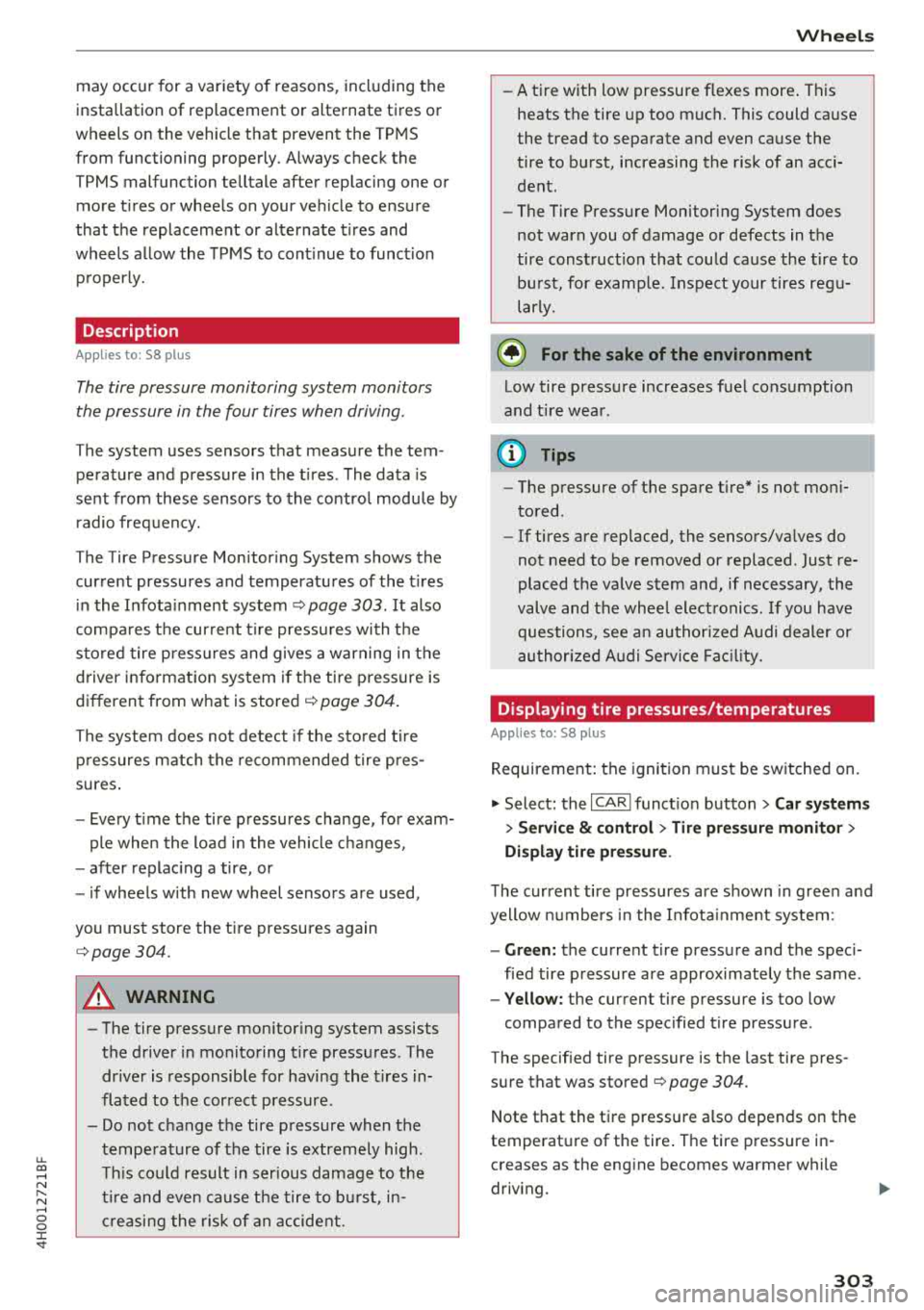
u. co .... N
" N .... 0 0 :c '
installation of replacement or alternate tires or
wheels on the vehicle that prevent the TPMS
from functioning properly . Always check the
TPMS malfunction telltale after replacing one or
more tires or wheels on your vehicle to ensure
that the replacement or alternate tires and
wheels allow the TPMS to continue to function
properly.
Description
Applies to: 58 plus
The tire pressure monitoring system monitors
the pressure in the four tires when driving.
The system uses sensors that measure the tem
perature and pressure in the tires . The data is
sent from these sensors to the control module by
radio frequency.
The Tire Pressure Monitoring System shows the
current pressures and temperatures of the tires
in the Infota inment system
c:> page 303 . It also
compa res the current tire pressures with the
stored tire press ures and gives a warning in the
driver information system if the tire pressure is
different from what is stored
c:> page 304.
The system does not detect if the stored tire
pressures match the recommended tire pres
sures.
- Every time the tire pressures change, for exam-
ple when the load in the vehicle changes,
- after replac ing a tire, or
- if wheels with new wheel sensors are used,
you must store the tire pressures again
c:> page 304.
A WARNING
-The tire pressure mon itor ing system assists
the driver in monitoring tire pressures. The
dr iver is responsible for having the tires in
flated to the correct pressure.
- Do not change the tire pressure when the
temperature of the tire is extremely high.
T his cou ld result in serious damage to the
t ir e and even cause the tire to burst, in
creasing the risk of an accide nt.
Wheels
-A tire with low pressure flexes more . This
heats the tire up too much. This could cause
the tread to separate and even cause the
tire to burst, increasing the risk of an acci
dent.
- The Tire Pressure Monitoring System does
not warn you of damage or defects in the
tire construct ion that could cause the tire to
burst, for example. Inspect your tires regu
larly.
@ For the sake of the environment
Low tire pressure increases fuel consumption
and tire wear.
(D Tips
-The pressure of the spare t ire* is not mon i
tored.
- If tires are replaced, the sensors/va lves do
not need to be removed or replaced. Just re
placed the valve stem and, if necessary, the
valve and the whee l electronics . If you have
questions, see an authorized Audi dealer or
authorized Audi Service Facility.
Displaying tire pressures/temperatures
Applies to: 58 plus
Requirement: the ignition must be switched on.
.. Select: the I CAR! funct ion button > Car systems
> Service & control > Tire pressure monitor >
Display tire pressure .
The current tire pressures are shown in green and
yellow numbers in the Infotainment system:
-Green: the current tire pressure and the spec i
fied tire pressure are approx imately the same .
-Yellow: the current tire pressure is too low
compared to the specified tire pressure .
The specified tire pressure is the last tire pres
sure that was stored
c:> page 304 .
Note that the tire pressure also depends on the
temperature of the tire . The tire pressure in
creases as the engine becomes warmer while
driv ing.
.,.
303
Page 349 of 356
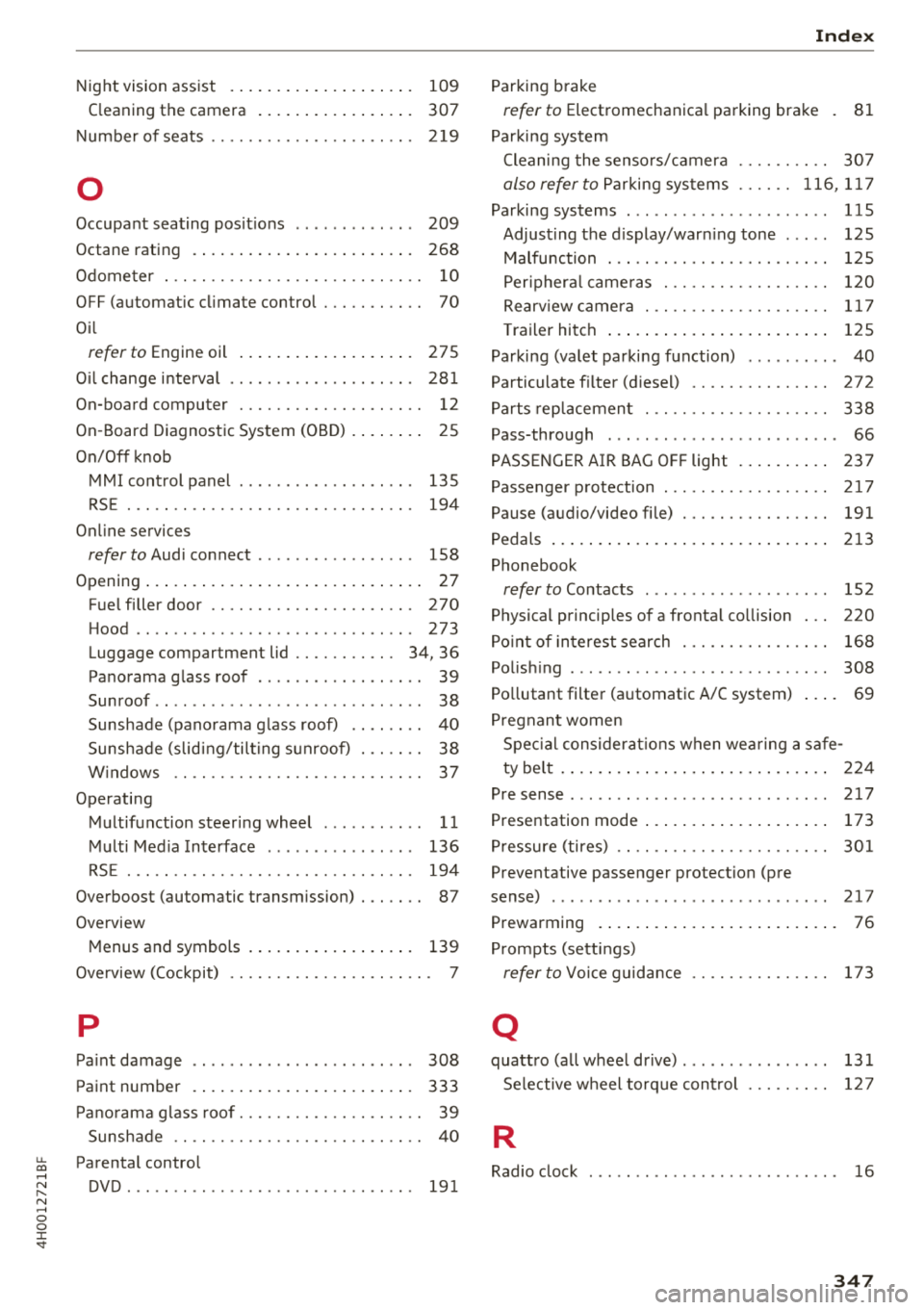
u. co .... N
" N .... 0 0 :c '
C leaning the camera . . . . . . . . . . . . . . . . . 307
Number of seats ............... .. .. .. . 219
0
Occupant seating pos it ions 209
Octane rating . . . . . . . . . . . . . . . . . . . . . . . . 268
Odometer . . . . . . . . . . . . . . . . . . . . . . . . . . . . 10
OFF (automatic climate control . . . . . . . . . . . 70
Oi l
refer to Engine oil . . . . . . . . . . . . . . . . . . . 275
O il change interval . . . . . . . . . . . . . . . . . . . . 281
On-board computer . . . . . . . . . . . . . . . . . . . . 12
On-Board Diagnostic System (OBD) . . . . . . . . 25
On/Off knob MMI control panel . . . . . . . . . . . . . . . . . . . 135
RSE . . . . . . . . . . . . . . . . . . . . . . . . . . . . . . . 194
Online services
refer to Audi connect . . . . . . . . . . . . . . . . . 158
Opening ..... .. ................ ..... .. 27
Fuel filler door . . . . . . . . . . . . . . . . . . . . . . 2 70
Hood .. .. .. .. ............... .. .. .. . 273
Luggage compartment lid . . . . . . . . . . . 34, 36
Panorama glass roof . . . . . . . . . . . . . . . . . . 39
Sunroof . . . . . . . . . . . . . . . . . . . . . . . . . . . . . 38
Sunshade (panorama glass roof) . . . . . . . . 40
Sunshade (sliding/tilting sunroof) . . . . . . . 38
W indows . . . . . . . . . . . . . . . . . . . . . . . . . . . 37
Operating Multifunction steering wheel . . . . . . . . . . . 11
Multi Media Interface . . . . . . . . . . . . . . . . 136
RSE . . . . . . . . . . . . . . . . . . . . . . . . . . . . . . . 194
Overboost (automatic transmission) . . . . . . . 87
Overview Menus and symbols . . . . . . . . . . . . . . . . . . 139
Overview (Cockpit) . . . . . . . . . . . . . . . . . . . . . . 7
p
Paint damage . . . . . . . . . . . . . . . . . . . . . . . . 308
Paint number . . . . . . . . . . . . . . . . . . . . . . . . 333
Index
Parking brake
refer to Electromechanical parking brake . 81
Parking system Cleaning the sensors/camera . . . . . . . . . . 307
o/sorefertoParkingsystems ...... 116,117
Parking systems . . . . . . . . . . . . . . . . . . . . . . 115
Adjusting the display/warning tone . . . . . 125
Malfunction . . . . . . . . . . . . . . . . . . . . . . . . 125
Peripheral cameras . . . . . . . . . . . . . . . . . . 120
Rearv iew camera . . . . . . . . . . . . . . . . . . . . 117
T railer hitch . . . . . . . . . . . . . . . . . . . . . . . . 125
Parking (valet parking function) . . . . . . . . . . 40
Particulate filter (diesel) . . . . . . . . . . . . . . . 272
Parts replacement . . . . . . . . . . . . . . . . . . . . 338
Pass-through . . . . . . . . . . . . . . . . . . . . . . . . . 66
PASSENGER AIR BAG O FF light . . . . . . . . . . 237
Passenger protection . . . . . . . . . . . . . . . . . . 217
Pause (audio/video file) . . . . . . . . . . . . . . . . 191
Pedals . . . . . . . . . . . . . . . . . . . . . . . . . . . . . . 213
Phonebook
refer to Contacts . . . . . . . . . . . . . . . . . . . . 152
Physical principles of a frontal collision . . . 220
Point of interest search . . . . . . . . . . . . . . . . 168
Polishing . . . . . . . . . . . . . . . . . . . . . . . . . . . . 308
Pollutant filter (automatic A/C system) . . . . 69
Pregnant women Spec ial considerat ions when wearing a safe-
ty be lt . . . . . . . . . . . . . . . . . . . . . . . . . . . . . 224
Pre sense . . . . . . . . . . . . . . . . . . . . . . . . . . . . 217
Presentation mode . . . . . . . . . . . . . . . . . . . . 173
Pressure (tires) . . . . . . . . . . . . . . . . . . . . . . . 301
Preventative passenger protection (pre
sense) . . . . . . . . . . . . . . . . . . . . . . . . . . . . . . 217
Prewarming . . . . . . . . . . . . . . . . . . . . . . . . . . 76
Prompts (settings)
refer to Voice guidance . . . . . . . . . . . . . . . 173
Q
quattro (all wheel drive) ................ 131
Selective wheel torque control 127
Panorama glass roof. . . . . . . . . . . . . . . . . . . . 39
Sunshade . . . . . . . . . . . . . . . . . . . . . . . . . . . 40
R
Parental control
Radio clock . . . . . . . . . . . . . . . . . . . . . . . . . . . 16
DVD ..... .. .. ................ ... .. . 191
347